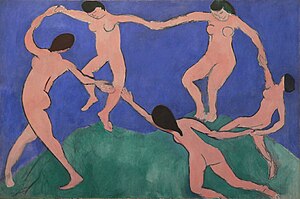"A valid interpretation of an artwork is dependent on an understanding of the artist’s intent and the context in which it was created."
Interpreting an artwork is something that anyone with a creative mind can do. Whether or not highly educated in visual art, any viewer can easily interpret that blocks of colour in Cezanne's Le Mont Sainte-Victoire, make up a mountain and scenery; any viewer can easily interpret that the figures in Henri Matisse's Dance (I) are doing a celebratory group dance. The thing about interpreting artworks is that it is something very subjective. A single artwork will allow for a wide range of interpretations, and usually, there is no right, no wrong, and no absolutely "correct" interpretation.
However, the issue at hand is whether or not the in-depth understanding of the artist's intent, or the context in which it was created, is necessary for a valid interpretation. The key word here is "valid", which, according to the dictionary definition, means "having some foundation; based on truth".
Sure, anyone can come up with his or her interpretation of Lucia Hartini's Srikandi. But the difference lies between having prerequisites, having the context to make what we call valid interpretations, as compared to purely seeing and creating one's own story. For example, someone who is unaware of the background to Hartini's painting might make such an interpretation: "This work is about a lady in a blue dress, whom we can see is someone sure of herself, as she looks into the staring eyeballs with confidence and without a glimpse of fear". Such an interpretation is generally a good one. However, with a little prior knowledge of the context which the work was created, a much more substantial interpretation can be easily formed: "In this work, Lucia Hartini casts Srikandi in such strong light, portraying a stark representation of herself, someone who had finally emerged victorious against the eyes of scrutiny of the society she lived in." This is when the 'good' interpretation truly becomes a 'valid' one. (Once again, note that the previous interpretation is NOT wrong/ invalid)
How can an interpretation be based on truth (i.e., facts that lead to the writer's intent for every symbol, every colour used) if it were solely based on what the viewer sees with his or her naked eye? In fact, sometimes, without the necessary knowledge of the context of the painting, invalid interpretations might tend to surface. For example, ask anyone who lacks prior knowledge regarding Jan Van Eyck's The Arnolfini Portrait, and the probability that they'll interpret Giovanna Cenami to be a pregnant lady is very, very high. But anyone with contextual knowledge will know that she is merely wearing a dress considered to be fashionable for women at that time, with not much of a hidden meaning behind the bulge.
In conclusion, I believe that everyone is free to interpret any artwork in any way possible. If a viewer were to see Henri Matisse’s The Snail as nothing but a colourful paper collage, who is to judge the substance of their interpretation? However, to sum up this essay, a truly valid interpretation has to be dependent on a true understanding of the artist’s intent and the context in which it was created, be it the artist’s childhood, family background, emotions, etcetera. Usually, it is only then that the viewer can find the “snail”, resulting in more accurate and accountable interpretations of artworks.
*Note: Images of paintings mentioned in this essay can be seen under jumpbreak.
The Arnolfini Portrait (1434)
Jan van Eyck

Srikandi (1993)
Lucia Hartini

Dance (I) (1909)
Henri Matisse

Le Mont Sainte-Victoire (1902-04)
Paul Cezanne

The Snail (1953) Henri Matisse

No comments:
Post a Comment